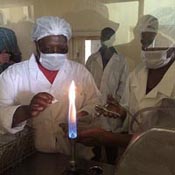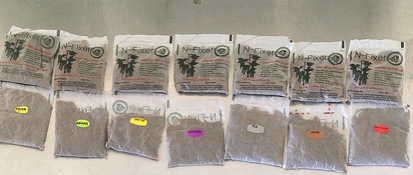During the N2Africa Field Visits 2016 in Zimbabwe, we visited the inoculant factory in Marondera. The Soil Productivity Research Laboratory (SPRL) in Marondera, Zimbabwe hosts the government-owned inoculant factory of Zimbabwe. It is the sole facility in the country and was opened in 1962 (Corby, 2011)1. In the early days, the inoculant factory produced inoculants for pasture legumes, mainly lucerne and clover species. Production of soyabean inoculants commenced in 1967. The factory is supported by a non-profit, government-owned microbiology laboratory which sets standards, performs inoculant quality-control duties and maintains the Grasslands Rhizobium Collection (Marufu et al., 1995)2, (Giller et al., 2011)3.
In 2015, the factory produced about 50,000-60,000 packages (each pack weighs 50 g) of legume inoculants from September - November. The factory has an annual capacity of over 180,000 packs, which is directly related to the actual demand. About 90% of the produced inoculants are for the production of soyabean, although inoculants are also made for Phaseolus vulgaris, Pisum sativum, Lens culinaris, Trifolium spp., Medicago sativa, Desmodium spp., Arachis hypogaea, Stylosanthes spp., Crotalaria juncea (Bala et al., 2011)4. The Medicago sativa inoculants are only made on demand.
 |
Production of inoculant at the SPRL Inoculant factory in Marondera, Zimbabwe (Photo Minke Stadler, 2016) |
 |
The recently published manual "Working with rhizobia" (Howieson and Dilworth, 2016)5 provides scientists and technicians modern guidelines for ensuring that the legume symbiosis with rhizobia is optimised. Chapter nine of this manual addresses the steps and procedures used in inoculant production and quality control.
The quality of the produced inoculants is ensured by the inoculant quality control (QC) system. Randomly selected samples are taken from each production step and tested at the laboratory to control the quality. In the incubator, the produced inoculated packs are kept at 28°C for 14 days, after which they are graded for fungal contamination. The approved high quality inoculants are stored at 4°C, until they are distributed to the governmental headquarters in Harare and approved agro-dealers, where the packages are sold to smallholder farmers.
We will continue to support all countries to establish robust quality control procedures, also at other stages through the supply chain (storage, transport and delivery). N2Africa will also support the SPRL inoculant production facility in Zimbabwe to improve and guarantee that consistent quality inoculants are delivered to farmers. Possibilities to export inoculants to Mozambique and Malawi are further explored.
We would like to thank Mrs. Mazvita Chiduwa for her clear clarification and guidance during our visit. Mazvita is back in charge of inoculant production at SPRL while completing her PhD thesis funded by N2Africa.
Minke Stadler
4Bala, A., Karanja, N., Murwira, M., Lwimbi, L., Abaidoo, R. and Giller,K. (2011). Production and use of Rhizobial inoculants in Africa, www.N2Africa.org, 21 pp. 1Corby, H.D.L. (2011). The Bagacillo legume-inoculant. Retrieved March 21th, 2016 from http: //www.hdlcorby.com. 3Giller, K.E., Murwira, M.S., Dhliwayo, D.K.C., Mafongoya, P.L. & Mpepereki, S. (2011) Soyabeans and sustainable agriculture in southern Africa. International Journal of Agricultural Sustainability, 9, 50-58. 5Howieson J.G. and Dilworth M.J. (Eds.). (2016). Working with rhizobia. Australian Centre for International Agricultural Research: Canberra. 2Marufu, L. Karanja, N. and Ryder, M. (1995). Legume inoculant production and use in East and Southern Africa. Soil Biology and Biochemistry, 21(415), 735-738.
